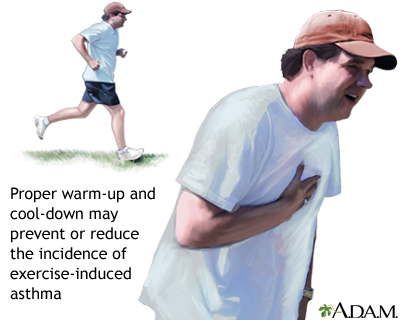Exercise-induced bronchoconstriction
Description
Sometimes exercise triggers asthma symptoms. This is called exercise-induced bronchoconstriction (EIB). In the past this was a called exercise-induced asthma. Exercise does not cause asthma, but it can cause airways to constrict (narrow). Most people with asthma have EIB, but not everyone with EIB has asthma.
The symptoms of EIB are coughing, wheezing, a feeling of tightness in your chest, or shortness of breath. Most times, these symptoms start soon after you stop exercising. Some people may have symptoms after they start exercising.
Patient Education Video: Asthma
Alternative Names
Wheezing - exercise-induced; Reactive airway disease - exercise; Exercise-induced bronchoconstriction
Be Careful Where and When you Exercise
Having asthma symptoms when you exercise does not mean you cannot or should not exercise. But be aware of your EIB triggers.
Cold or dry air may trigger asthma symptoms. If you do exercise in cold or dry air:
- Breathe through your nose.
- Wear a scarf or mask over your mouth.
Do not exercise when the air is polluted. Avoid exercising near fields or lawns that have just been mowed.
Warm up before you exercise, and cool down afterward:
- To warm up, walk or do your exercise activity slowly before you speed up.
- The longer you warm up, the better.
- To cool down, walk or do your exercise activity slowly for several minutes.
Some kinds of exercise may be less likely to trigger asthma symptoms than others.
- Swimming is a good sport for people with EIB. The warm, moist air helps keep asthma symptoms away.
- Football, baseball, and other sports with periods when you do not move fast are less likely to trigger your asthma symptoms.
Activities that keep you moving fast all the time are more likely to trigger asthma symptoms, such as running, basketball, or soccer.
Use Your Asthma Medicine Before you Exercise
Take your short-acting, or quick-relief, inhaled medicines before you exercise.
- Take them 10 to 15 minutes before exercise.
- They can help for up to 4 hours.
Long-acting, inhaled medicines may also help.
- Use them at least 30 minutes before exercise.
- They can help for up to 12 hours. Children can take this medicine before school, and it will help for the whole day.
- Be aware that using this kind of medicine every day before exercise will make it less effective over time.
Follow your health care provider's advice on which medicines to use and when.
Gallery

References
Lugogo N, Que LG, Carr TF, Kraft M. Asthma: diagnosis and management. In: Broaddus VC, Ernst JD, King TE, et al, eds. Murray and Nadel's Textbook of Respiratory Medicine. 7th ed. Philadelphia, PA: Elsevier; 2022:chap 62.
National Heart, Lung and Blood Institute. Asthma Management Guidelines: Focused Updates 2020. www.nhlbi.nih.gov/health-topics/asthma-management-guidelines-2020-updates. Updated February 4, 2021. Accessed April 25, 2022.
Nowak RM, Tokarski GF. Asthma. In: Walla RM, Hockberger RS, Gausche-Hill M, eds. Rosen's Emergency Medicine: Concepts and Clinical Practice. 9th ed. Philadelphia, PA: Elsevier; 2018:chap 63.
Secasanu VP, Parsons JP. Exercise-induced bronchoconstriction. In: Miller MD, Thompson SR, eds. DeLee, Drez, & Miller's Orthopaedic Sports Medicine. 5th ed. Philadelphia, PA: Elsevier; 2020:chap 13.
Weiler JM, Brannan JD, Randolph CC, et al. Exercise-induced bronchoconstriction update - 2016. J Allergy Clin Immunol. 2016;138(5):1292-1295.e36. PMID: 27665489 pubmed.ncbi.nlm.nih.gov/27665489/.